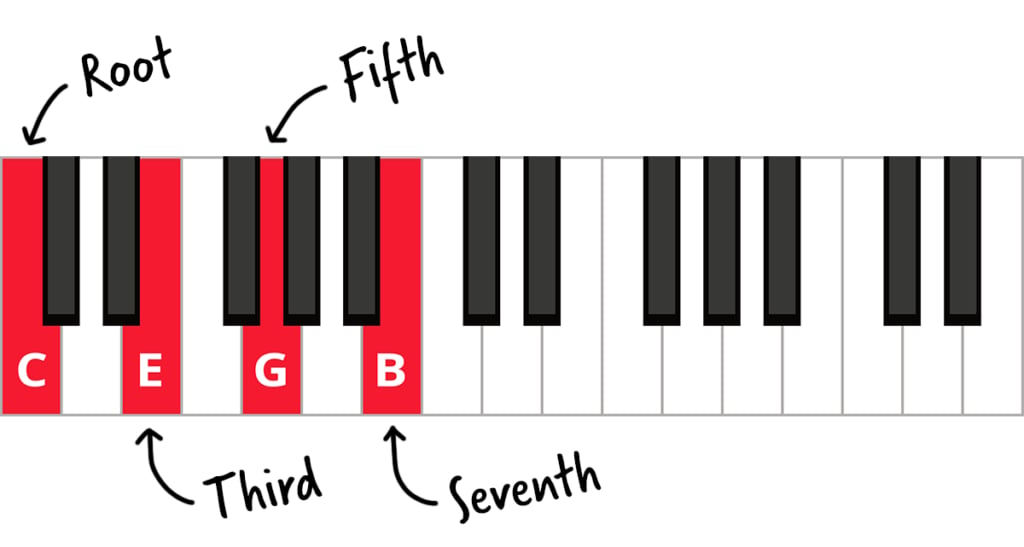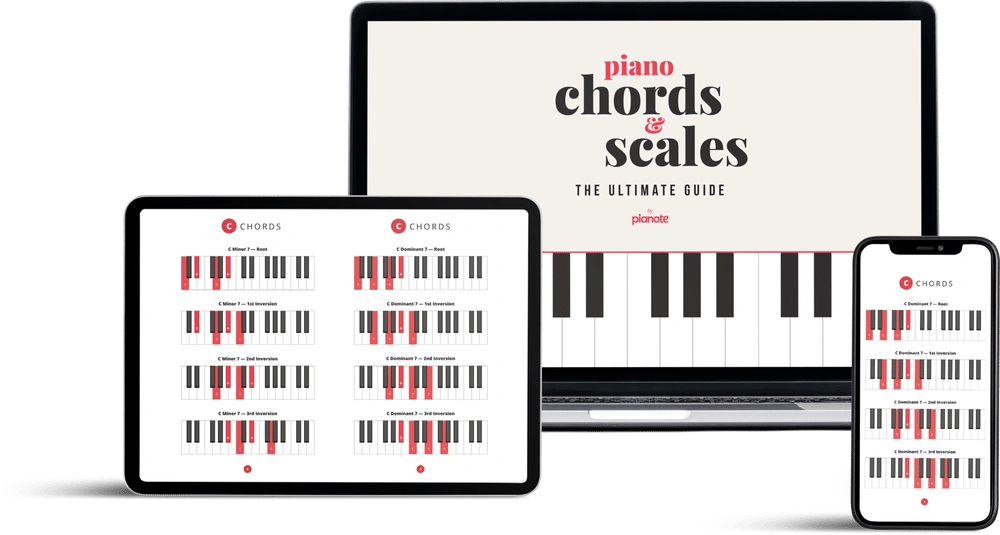7th chords on piano are some of my absolute favorite chords. But they weren’t always. In fact, they used to confuse me so much, I’d run for the hills when I saw a “7” on a chord chart. I avoided them, and because of that, I missed out on creating some of the most beautiful sounds you can make on a piano.
The reason I ran was because 7th chords on piano are confusing! There are so many types. You’ve got your Cmaj7 and Cm7. Then you’ve got C7, which sounds a little like Cmaj7, but not really. And then there’s Cdim7 and Cm7♭5…
So, in this lesson, we’ll break down the differences between these chords and explain in clear and simple terms the theory behind them. 7th chords on piano do not need to be confusing!
Table of Contents:
Inspiring tutorials. Fascinating articles. Exclusive interviews. We create piano content anyone, anywhere can enjoy for free. Don’t miss out, sign up for more free lessons.
7th chords are associated with jazz music, where the extra seventh adds a crunchy, yet pretty (!) tension to the chord. In fact, you can instantly “jazz up” a song using 7th chords. Like this.
7th chords on piano are four-note chords. The note the chord is named after is called the root; so, a Cmaj7 chord has C as its root. The other notes in the chord are the third, the fifth, and the seventh. Here’s a Cmaj7 chord in root position:

We’ll be using formulas to explain 7th chords. Please consider these formulas in the context of a major key. So, the formula 1-♭3-5-♭7 means flatting the third and seventh of the major key.
You’ll need a basic understanding of triads and intervals for this lesson. If those concepts are new, consider reviewing these lessons first:
The Piano Chords & Scales book is one of our top-selling products of all time. Now, you can get it electronically for free. That means you can instantly look up scales and chords on your phone, tablet, or laptop without hunting for WiFi. The book contains major, blues, pentatonic, and all three minor scales. Plus major, minor, and 7th chords in all inversions, and sus chords.

Name: “Major seventh” chord, “major seven” chord
Formula: 1-3-5-7
Chord Symbols: Cmaj7, CΔ7, CM7
Sometimes called the “major 7,” the major 7th chord is built by taking a major triad and then adding a major seventh on top. You can also think of the major 7th chord as containing the first, third, fifth, and seventh notes of the major scale. Here are all the major 7th chords in all twelve keys:
Cmaj7
C-E-G-B

Dmaj7
D-F#-A-C#

Emaj7
E-G#-B-D#

F#maj7
F#-A#-C#-E#

A♭maj7
A♭-C-E♭-G

B♭maj7
B♭-D-F-A

D♭maj7
D♭-F-A♭-C

E♭maj7
E♭-G-B♭-D

Fmaj7
F-A-C-E

Gmaj7
G-B-D-F#

Amaj7
A-C#-E-G#

Bmaj7
B-D#-F#-A#

Name: Dominant seventh chord, five-seven chord
Formula: 1-3-5-♭7
Chord Symbol: C7
The dominant 7th chord is one of the most commonly used 7th chords in music. It’s extremely popular in blues and pop. The major 7th and the dominant 7th are similar, but in the dominant 7th, we lower the seventh by one half-step. So, the distance between the root and the seventh is a minor 7th interval and the formula for this chord is 1-3-5-♭7.
Why is this chord “dominant”? Dominant is a fancy word for “fifth note of the scale.” Dominant 7th chords are built on the fifth note of a major scale and they follow that scale’s key signature. In the case of C7, C is the fifth note of F major, which has B-flat. Therefore, C7 is C-E-G-B♭.
Here are all the dominant 7th chords in all twelve keys:
C7
C-E-G-B♭

D7
D-F#-A-C

E7
E-G#-B-D

F#7
F#-A#-C#-E

A♭7
A♭-C-E♭-G♭

B♭7
B♭-D-F-A♭

D♭maj7
D♭-F-A♭-C♭

E♭7
E♭-G-B♭-D♭

F7
F-A-C-E♭

G7
G-B-D-F

A7
A-C#-E-G

B7
B-D#-F#-A

Name: Minor seven chord, minor seventh chord
Formula: 1-♭3-5-♭7
Chord Symbol: Cm7, C-7
Building a minor 7th chord is the same principle as building a major 7th chord. You just take a minor triad and then add the 7th note of the minor scale. You can also think of this as taking a minor triad and adding a minor 7th interval. Here are all the minor 7th chords in all twelve keys:
Cm7
C-E♭-G-B♭

Dm7
D-F-A-C

Em7
E-G-B-D

F#m7
F#-A-C#-E

A♭m7
A♭-C♭-E♭-G♭

B♭m7
B♭-D♭-F-A♭

C#m7
C#-E-G#-B

E♭m7
E♭-G-B♭-D♭

Fm7
F-A♭-C-E♭

Gm7
G-B♭-D-F

Am7
A-C-E-G

Bm7
B-D-F#-A

Name: Diminished seventh chord
Formula: 1-♭3-♭5-♭♭7
Chord Symbol: Cdim7, Co7
Remember earlier how I said I would run for the hills whenever I saw 7ths on a chord chart? Well, this one had me running for Mt. Everest!
But diminished 7th chords are actually very easy to make. All they are is a stack of minor thirds. To build a diminished seventh chord, stack together the root, the flat third, the flat fifth, and a double-flatted seventh. Watch out for that double flat; in Cdim7, the B♭♭ is the same pitch as A. Here are diminished 7th chords in all twelve keys:
Cdim7
C-E♭-G♭-B♭♭

Ddim7
D-F-A♭-C♭

Edim7
E-G-B♭-D♭

F#dim7
F#-A-C-E♭

A♭dim7
A♭-C♭-E♭♭-G♭♭

B♭dim7
B♭-D♭-F♭-A♭♭

C#dim7
C#-E-G-B♭

E♭dim7
E♭-G♭-B♭♭-D♭♭

Fdim7
F-A♭-C♭-E♭♭

Gdim7
G-B♭-D♭-F♭

Adim7
A-C-E♭-G♭

Bdim7
B-D-F-A♭

Name: Minor seven flat five, half-diminished seventh, half-diminished
Formula: 1-♭3-♭5-♭7
Chord Symbol: Cm7♭5, Cø7
The notation for this chord looks like a secret code that would require a genius to break! But it’s even simpler than the diminished 7th. In fact, the chord’s formula is in the name, “minor seven flat five”: simply take a minor 7th chord and flat the fifth (lower it by one half-step). And voilà, you have a half-diminished chord!
Here are all half-diminished chords in all twelve keys:
Cm7♭5
C-E♭-G♭-B♭

Dm7♭5
D-F-A♭-C

Em7♭5
E-G-B♭-D

F#m7♭5
F#-A-C-E

A♭m7♭5
A♭-C♭-E♭♭-G♭

C#m7♭5
C#-E-G-B

E♭m7♭5
E♭-G♭-B♭♭-D♭

Fm7♭5
F-A♭-C♭-E♭

Gm7♭5
G-B♭-D♭-F

Am7♭5
A-C-E♭-G

And that is how 7th chords are made! Hopefully, they’re not as scary anymore. And now that you know how to make them, I really encourage you to try and use them in your playing. They can add so much texture and emotion to your songs.
Here’s a table that summarizes all the chords we’ve discussed, using C as the root:
| Chord Name | Formula | Notes | Chord Symbols |
|---|---|---|---|
| C Major 7th Chord | 1-3-5-7 | C-E-G-B | Cmaj7, CΔ7, CM7 |
| C Dominant 7th Chord | 1-3-5-♭7 | C-E-G-B♭ | C7 |
| C Minor 7th Chord | 1-♭3-5-♭7 | C-E♭-G-B♭ | Cm7, C-7 |
| C Diminished 7th Chord | 1-♭3-♭5-♭♭7 | C-E♭-G♭-B♭♭ | Cdim7 |
| C Half-Diminished Chord | 1-♭3-♭5-♭7 | C-E♭-G♭-B♭ | Cm7♭5 |
Also, be sure to check out these resources:
Happy chording!
Learn wherever you want, whenever you want, whatever you want. Join Pianote today and learn to play pop, classical, jazz, and more with real teachers.
Lisa Witt has been teaching piano for more than 20 years and in that time has helped hundreds of students learn to play the songs they love. Lisa received classical piano training through the Royal Conservatory of Music, but she has since embraced popular music and playing by ear in order to accompany herself and others. Learn more about Lisa.


By signing up you’ll also receive our ongoing free lessons and special offers. Don’t worry, we value your privacy and you can unsubscribe at any time.
We use cookies for traffic data and advertising. Cookie Policy »